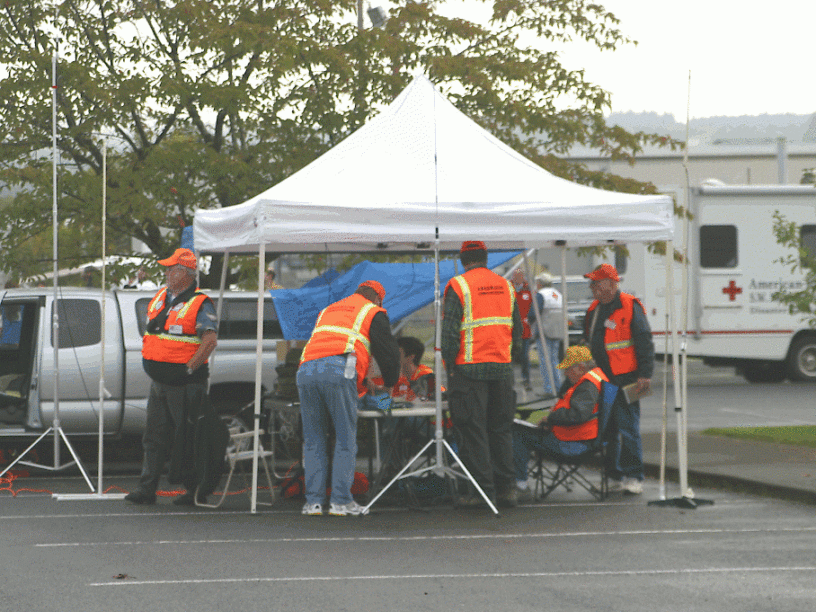Ham radio can be a critical communication tool in times of crisis when traditional communication methods are not available. In fact, ham radio operators are often called upon to provide emergency communications during disasters such as hurricanes, earthquakes, and other natural disasters.
Here are some of the reasons why ham radio is valuable in times of crisis:
- Independent infrastructure: Ham radio operators use their own equipment and frequencies to communicate, which means they are not reliant on traditional communication infrastructure such as phone lines or the internet. This independence allows them to communicate even if traditional methods are disrupted.
- Long-range communication: Ham radio can transmit over long distances, allowing operators to communicate with other operators across the country or even around the world. This can be critical in situations where traditional communication methods are not available or have limited reach.
- Flexibility: Ham radio can be used for a variety of communication needs, including voice, text, and data transmissions. This flexibility allows operators to communicate important information such as weather updates, emergency alerts, and status reports.
- Community support: Ham radio operators often have strong bonds within their community and can work together to provide support during a crisis. This may include providing assistance to first responders, coordinating with other ham radio operators to establish communication networks, or assisting with search and rescue efforts.
- Redundancy: In addition to being independent of traditional communication infrastructure, ham radio can also provide redundancy in communication. If one frequency or mode of communication is disrupted, operators can switch to another frequency or mode to continue communicating.
- Availability in remote areas: In remote areas or areas with limited infrastructure, cell phone service may be unreliable or non-existent. Ham radio can provide an alternative means of communication in these areas, allowing operators to stay connected even in the absence of traditional communication methods.
Ham radio operators have played a crucial role in providing emergency communication during natural disasters. Here are a few examples of how ham radio has been used during natural disasters:
- Hurricane Katrina (2005): After Hurricane Katrina devastated the Gulf Coast, ham radio operators were called upon to provide emergency communication. Many cell phone towers and other communication infrastructure were damaged or destroyed, leaving many people without communication options. Ham radio operators set up communication networks and relayed messages between emergency responders and victims, providing critical information and assistance.
- Hurricane Maria (2017): In the aftermath of Hurricane Maria, which devastated Puerto Rico, ham radio operators provided a lifeline of communication to the island. With much of the island’s infrastructure destroyed, ham radio operators provided emergency communication between hospitals, rescue workers, and other agencies.
- Joplin Tornado (2011): When a massive tornado hit Joplin, Missouri, ham radio operators sprang into action to provide critical communication during the disaster. The ham radio operators relayed messages between emergency responders and assisted with search and rescue efforts.
- Indian Ocean Tsunami (2004): After the devastating Indian Ocean tsunami in 2004, ham radio operators provided communication support to aid organizations and relief agencies. Ham radio operators were able to quickly establish communication links and relay information to support the relief efforts.
- California Wildfires (2018): During the California wildfires in 2018, ham radio operators provided critical communication support to firefighters and other emergency responders. With much of the communication infrastructure in the area damaged or destroyed, ham radio provided an alternative means of communication for emergency responders.
Overall, ham radio has played a crucial role in providing emergency communication during natural disasters, helping to save lives and support relief efforts. Ham radio operators often volunteer their time and equipment to provide this critical service, demonstrating the value of the hobby in times of crisis. It’s important for ham radio operators to be prepared and trained to provide this critical service when needed.
Ham radio operators who are involved in emergency communication should be familiar with The Incident Command System (ICS) and receive appropriate training. ICS is a standardized emergency management system used by many government agencies and emergency responders in the United States. Here are some ICS training courses that ham radio operators may find helpful:
- ICS-100: Introduction to the Incident Command System: This course provides an introduction to ICS and is designed for individuals who may be involved in emergency response but who are not part of the formal emergency management structure.
- ICS-200: ICS for Single Resources and Initial Action Incidents: This course provides an overview of ICS and is designed for individuals who may be involved in smaller-scale incidents or who may be assigned to a single resource.
- ICS-300: Intermediate ICS for Expanding Incidents: This course is designed for individuals who may be involved in more complex incidents or who may be responsible for managing multiple resources.
- ICS-400: Advanced ICS for Command and General Staff: This course is designed for individuals who may be involved in large-scale incidents or who may be responsible for managing multiple teams or divisions within an incident.
- ICS-700: National Incident Management System (NIMS), An Introduction: This course provides an overview of the NIMS, which is a national framework for managing emergencies and incidents.
- ICS-800: National Response Framework (NRF), An Introduction: This course provides an overview of the NRF, which is a national framework for responding to emergencies and incidents.
Overall, ham radio operators who are involved in emergency communication should receive appropriate ICS training to be prepared to work effectively with emergency responders and other agencies during incidents and emergencies. All of the above courses are provided for free, in an online self-study model from the U.S. Fire Administration.

